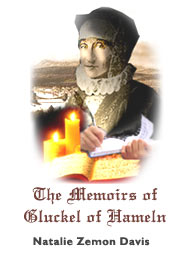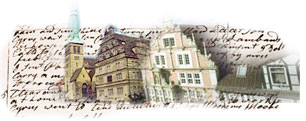|
|
JHOM - Personalities - Gluckel - Memoirs

|
Glückel
began the Memoirs just after Haim's death, expressing her hope
that writing them would help to dispel her grief. She also intended
to tell her children about their family background. She completed
the seventh and final book in 1719, five years before she died on
September 19, 1724, at the age of seventy-eight. The Memoirs
come to us through two copies of her manuscript made by members of
her family. From these two manuscripts, we learn from scholar Natalie
Z. Davis,
a Yiddish edition,
with notes, index and introduction was assembled and published by
David Kaufmann in 1896. It was used for translations to German, Hebrew
and English. The American edition has been in print since 1932.
|
There are
some interesting contrasts between the sources of Christian and Jewish autobiography
that help us understand Glikl's
mixing of genres — that is, her blend of memoir
and story. Christian life history was often a spinoff from an account book
and/or from a record of births, marriages, and deaths penned into a book of
hours, Bible, religious calendar, or other devotional text....
Jewish life
history [meanwhile] was fostered especially by the centuries-old "ethical
will," an exposition of moral lessons and personal wisdom passed on to
one's children along with instructions for one's burial and the disposition
of one's goods. These were texts that had some circulation and reputation.
In her manuscript, Glikl
speaks of the will of her sister's mother-in-law, "the pious Pessele,
[who] had no equal in the world with the exception of our Mothers —
Sarah, Rebecca, Rachel, and Leah.... It is a wonder to read the testament
that she made, may she rest in peace. I cannot write of it, but anyone who
wishes to read it can still find it with her children; they would surely not
have thrown it away." ...When the autobiography took over from the will,
the impulse to moralizing still remained strong: one could make the life itself
exemplary; one could add religious poetry and lament ... one could tell stories,
as did Glikl.
There is
a confessional strain in both Jewish and Christian autobiography, but it operates
quite differently within the two traditions. For the Christians, the major
model was still Augustinian confession with a definitive conversion.... With
Jewish confessional autobiography of the seventeenth century, the model is
not a personal trajectory but the history of Yahweh's chosen people, the individual
life repeating and recombining the rhythm of Torah, sinning and the sufferings
of exile.[1]
Glikl
bas Judah Leib's autobiography fits within this general Jewish frame, but
has original features connected with her gender and her learning. . . . Glikl
respected [Jewish] learning and sent two of her sons who "studied well"
to Talmudic schools in Poland and Frankfurt. But her own culture was of another
kind, characteristic of the most bookish of the Ashkenazic merchant women.
She had attended cheder, the Jewish primary school: "my father
educated his children, son and daughters both, in things heavenly and worldly."
In subsequent years, she had acquired numerous books in Yiddish —
that is, in what she called "Taytsh" and what some Jewish contemporaries
referred to as "the language of the Ashkenaz." This literature,
always written in Hebrew characters, comprised several genres. There were
ethical tracts and manuals, there were Yiddish books on the religious and
household duties of women, there were women's books of prayers, especially
the tkhines * (prayers
published in booklets for a woman's individual devotion and recited according
to the rhythm of the Jewish holy days, as well as the rhythm of her own life,
body, and family affairs).[2]

|
|
|
|



